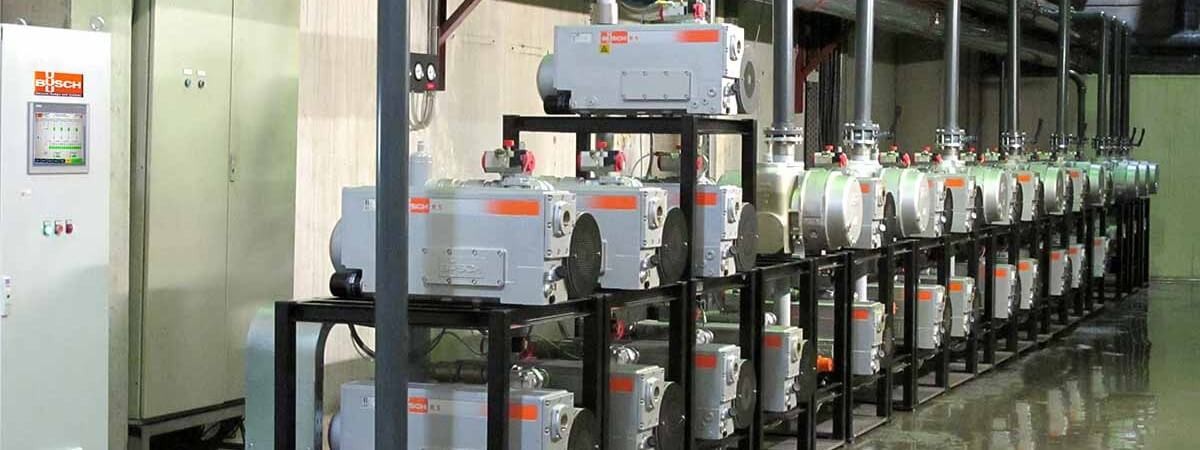Centralized Vacuum Supply for Reliable and Efficient Packaging
Westfleisch
Maulburg, Germany
|
06.01.2016
|
5 min
Westfleisch, one of the largest meat processing companies in Germany and Europe, is optimizing its vacuum supply with centralized vacuum systems from Busch. It has nine production facilities and a turnover of € 2500 million. About Westfleisch
The Westfleisch meat processing centre in Erkenschwick covers an area of 135,000 m
2, and slaughters between 30,000 and 40,000 pigs per week. 800 to 900 tons of meat products are manufactured weekly, mainly raw sausage, boiled sausage, and ham.
The extensive production areas are equipped with a Busch
centralised vacuum system supplying 30
packaging lines in several buildings. For Westfleisch this represents the most reliable and economical vacuum solution.
Westfleisch was founded in 1928 as a livestock cooperative, and is now one of the leading meat processing companies in Germany and Europe. More than 40% of production is exported, to over 40 countries. Over 4,000 farmers are contracted to produce pigs, cattle and calves, allowing Westfleisch to maintain detailed records of the origin, safety and quality of meat products throughout the production chain. Sales to end consumers are made through food retailers.
The Westfleisch group employs about 1900 staff, with its central administration located in Münster, Westphalia. Nine production sites carry out the slaughter, butchering, processing and finishing operations.
The first Busch centralized vacuum supply was installed at the Erkenschwick meat processing centre as early as 1990. Westfleisch in Erkenschwick now employs more than 1000 staff in a two-shift system five days a week. Some Saturdays are also worked if required by seasonal demand. The third shift carries out plant cleaning operations.
The continuous expansion of production capacity, subsequent extensions to the site, restructuring measures, and strict separation of the raw and cooked meat areas ("zoning") later led to the installation of a second centralized vacuum supply.
In 2013 Westfleisch decided that these two systems – located several hundred metres apart – should be replaced by a single vacuum supply.
The new system was to be centrally situated to minimize the pipework length to all packaging lines in buildings throughout the site.
The new system was to be centrally situated to minimize the pipework length to all packaging lines in buildings throughout the site. Previous experience at other Westfleisch sites with Busch vacuum technology and centralized vacuum supplies had been positive, so a Busch solution which met all requirements was chosen.
Process of vacuum packaging
Busch designed the system to provide the
shortest possible cycle times in all 30 thermoforming packaging lines.
- The packaging chambers are evacuated in two stages with a faster pressure response, reducing the cycle time to a minimum.
- This means that a part of the centralized supply comprises rough vacuum pumps which pre-evacuate the packaging to 50 mbar.
- A valve switches to the medium vacuum supply on demand, reducing the packaging pressure to between two and three millibar.
This is not only the fastest way to achieve ultimate pressure in the packaging, it is also the most efficient. This high efficiency is a result of the relatively small Busch
R5 rotary vane vacuum pumps used for rough vacuum generation. The medium vacuum supply is provided by
frequency-controlled PANDA boosters, activated only after the rough vacuum level has been achieved. A modular thermoforming vacuum supply provides vacuum at 160 mbar to the thermoforming stations. The vacuum is used to form the wrapping film into a tray in a mould.
The Busch centralised vacuum system is designed for expansion:
additional modules may be installed to meet increasing demand. An expansion became necessary at the beginning of 2015.
Benefits of the new vacuum system solution for the customer
Since this expansion in 2015, the extended centralized vacuum system has comprised a total of 18 rotary vane vacuum pumps and rotary lobe vacuum boosters. This is exactly the same number of units as the two vacuum supply systems used prior to 2013.
However, these two systems provided vacuum to 13 packaging machines, whereas the new centralised system now supplies vacuum to 30.
The combination of the two old systems to a single centralized vacuum supply has produced energy savings of 56%.
This means the combination of the two old systems to a single centralized vacuum supply has produced energy savings of 56%. The control system of the new vacuum supply is programmed to activate or deactivate vacuum modules as required to meet current demand.
The distance between the centralized vacuum supply and the individual packaging lines can be up to 400 metres. The Westfleisch site in Erkenschwick has a total of 1300 metres of PVC pipework for the rough, medium and thermoforming vacuum supplies.
After 10 months of operation the Westfleisch management expressed their complete satisfaction with the new vacuum system, and their confidence that the decision in favour of Busch systems was correct.
Busch Service
Besides energy savings, an important factor in the decision to use Busch systems was the availability of a
complete range of services from a single source. The overall project planning, design, construction, installation and commissioning of the system – including pipework – were carried out by Busch vacuum specialists.
Busch also offers an
all-inclusive servicing package in which Busch takes full responsibility for the vacuum system, carries out all maintenance tasks, and provides an immediate response if a fault should occur.
- Maintenance can be carried out by Busch technicians without production downtime, as individual vacuum modules may be disconnected from the vacuum network and reconnected after servicing.
- Service technicians do not require access to production areas – for reasons of hygiene a major advantage in the foodstuffs industry.
- A further benefit of centralized vacuum systems is the absence of heat emissions by vacuum pumps to the cooled production and packaging areas, resulting in significantly reduced energy costs for air conditioning.
Maulburg, Germany
|
06.01.2016
|
5 min
